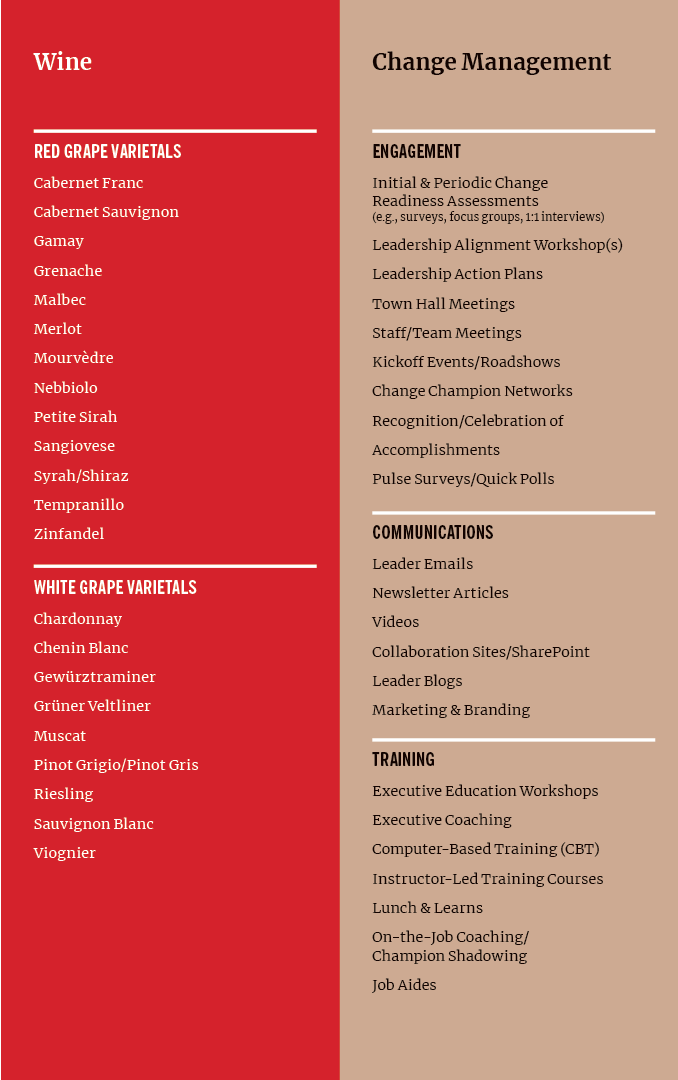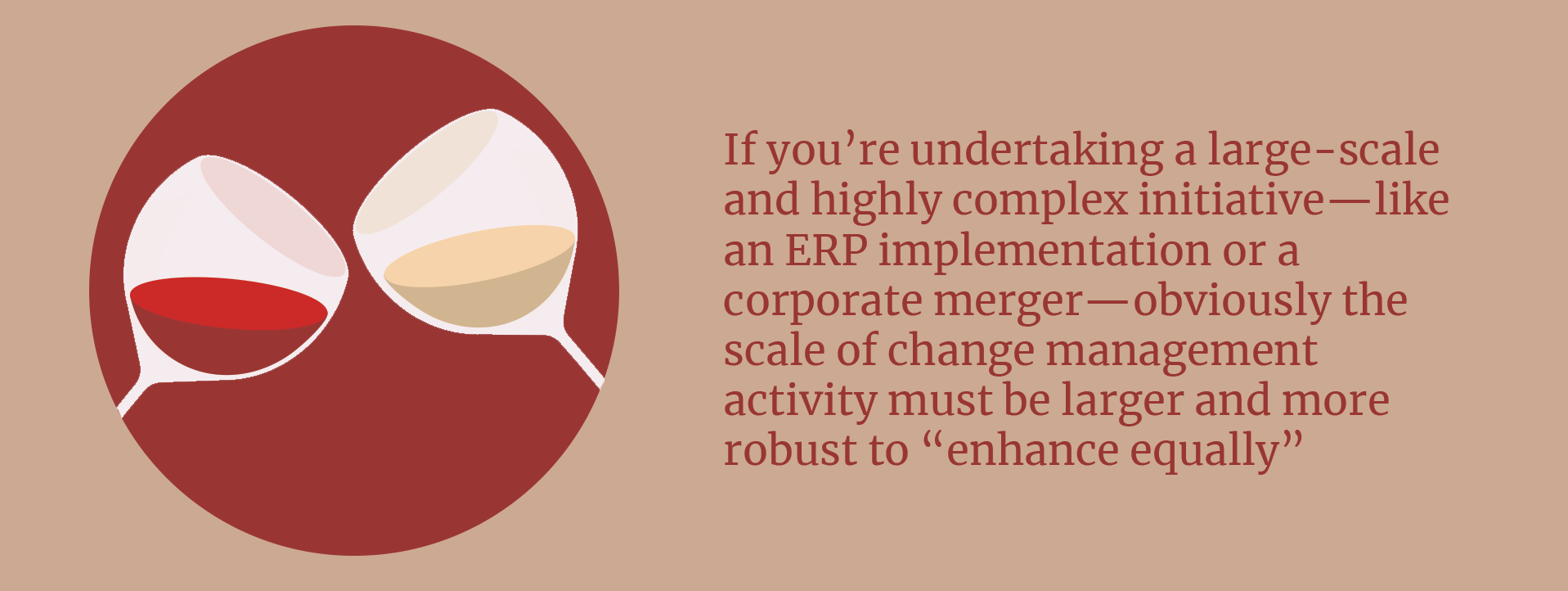The waiter slowly bends down asking what type of wine you would like to order, and you break into a light sweat. How can I possibly order a wine that will appeal to everyone and complement everyone’s meal? Someone has ordered beef. Others have ordered chicken and fish. Do we need a different wine for each course? You can’t possibly let them in on your secret: Your brother, the sommelier, was behind all your wonderful birthday selections!
Just as there is a time to call in the sommelier to help select a complementary wine with your meal, it is also important to understand the need for change management practitioners who can define a complementary “best-fit” approach to help employees understand, commit to, accept, and embrace changes in their business environment.
As change management practitioners, we are called upon to design and execute a readiness and adoption agenda that enables an organization to realize its goals. We do this work by focusing on the one variable standing between success and failure: people. We develop and deploy tactics to help affected stakeholders “bridge the gap” between implementation and adoption. We help them navigate with minimal disruption toward the “new normal” after changes in the company’s organization, technology, processes, or policies.
Finding the Sweet Spot
However, designing that “just right” change management program is equal parts art and science. Deploy too much training and your audience becomes complacent and fatigued. Communicate too little and stakeholders complain of being uninformed and left “out of the loop.”
There is a sweet spot between too much change management and too little. Finding it depends on scaling the change management agenda to complement the scope of the transformation itself.
This is what we call designing and executing against the “best-fit” change management approach for an initiative: developing a “plan of change management attack” that deploys the right tactics at the right time to the right stakeholders. No more than what’s needed—and certainly not less.
Let’s explore our menu of options. One of the most important considerations is preference. For change management, it is important to balance change activities against organizational preferences. Using our earlier analogy, when dealing with wine, personal preferences might overrule the defined norm.
Menu

For example, if your boss is indulging in a T-bone and garlic mashed potatoes, you want an aged Cabernet or Malbec that enhances the flavor profile of the steak. However, if one of your colleagues will be enjoying lobster ravioli with a tomato cream sauce, you could suggest a crisp Chardonnay that complements the richness of the shellfish. (Worth asking: is anyone else as hungry as we are right now?) Essentially, you’re seeking a balance that enhances both the wine and the food equally. That’s exactly what you should do when planning and deploying a change management program.
Let’s carry this concept back into the world of enterprise transformation. If you’re undertaking a large-scale and highly complex initiative—like an ERP implementation or a corporate merger—obviously the scale of change management activity must be larger and more robust to “enhance equally” this type of situation.
You’ll need the full-bodied Cabernet of change management to arrive at a complementary pairing with this transformation varietal.
Conversely, with a small-scale, less complex initiative—a minor change to travel and expense policy, for example—there’s no need to break out the change management Bordeaux. A light and fruity Pinot Grigio—in the flavor profile of awareness communication—is likely all that’s needed to prepare stakeholders for their “new normal.”
Where do you start when approaching the correct pairing of wine—or change management? Our approach starts by assessing overall complexity and character. Let’s look at the key dimensions change leaders should consider for each.

Determining the best wine to pair with your meal entails three basic considerations: taste, intensity, and strategy.*
![]() Identify your food and wine’s prominent characteristics. Whether the food is Asian or Italian, meat or vegetarian, focus on its boldest flavors: Is the food salty, acid, sweet, bitter, fatty, or spicy? Remember to consider the role dressings or sauces play in enhancing or altering those flavor profiles. Conversely, when we think about wine, we focus on a different set of characteristics: Is the wine sweet, acid, tannic, fruity, or bold in body? Typically, red wines tend to be more bitter; white, rosé, and sparkling wines tend to be more acid.
Identify your food and wine’s prominent characteristics. Whether the food is Asian or Italian, meat or vegetarian, focus on its boldest flavors: Is the food salty, acid, sweet, bitter, fatty, or spicy? Remember to consider the role dressings or sauces play in enhancing or altering those flavor profiles. Conversely, when we think about wine, we focus on a different set of characteristics: Is the wine sweet, acid, tannic, fruity, or bold in body? Typically, red wines tend to be more bitter; white, rosé, and sparkling wines tend to be more acid.
![]() Match food intensity with wine intensity. You might consider a salad to be a light meal, but the choice of dressing could influence its flavor intensity. Contrast a balsamic vinaigrette with a simple, more oil-rich dressing. The prominence of each taste component (see No. 1) can help guide you. Note that a lighter wine like Sauvignon Blanc still tends to have higher acidity. A bolder Chardonnay, however, tends not to be as acidic. Pinot Noir and Cabernet Sauvignon tend to fall on opposite ends of the scale in both body and tannins, which introduce more bitterness.
Match food intensity with wine intensity. You might consider a salad to be a light meal, but the choice of dressing could influence its flavor intensity. Contrast a balsamic vinaigrette with a simple, more oil-rich dressing. The prominence of each taste component (see No. 1) can help guide you. Note that a lighter wine like Sauvignon Blanc still tends to have higher acidity. A bolder Chardonnay, however, tends not to be as acidic. Pinot Noir and Cabernet Sauvignon tend to fall on opposite ends of the scale in both body and tannins, which introduce more bitterness.
![]() Develop a pairing strategy. Here’s where you’ll contrast sweetness and saltiness, fattiness and acidity. It’s a great strategy to develop complementary pairings—wines should be more acidic or sweeter than the food, for example, but with equal intensity. That’s why reds tend to pair best with red meat while white wines complement fish or poultry. More bitter red wines contrast with fat. Some experts even recommend matching wines with the entrée’s sauce, rather than the meat itself. White, sparkling, and rosé wines tend to complement meals by introducing contrasting flavors, while reds create balance by aligning with and amplifying similar flavors.
Develop a pairing strategy. Here’s where you’ll contrast sweetness and saltiness, fattiness and acidity. It’s a great strategy to develop complementary pairings—wines should be more acidic or sweeter than the food, for example, but with equal intensity. That’s why reds tend to pair best with red meat while white wines complement fish or poultry. More bitter red wines contrast with fat. Some experts even recommend matching wines with the entrée’s sauce, rather than the meat itself. White, sparkling, and rosé wines tend to complement meals by introducing contrasting flavors, while reds create balance by aligning with and amplifying similar flavors.
Defining the “best-fit” change management approach typically involves examining three key dimensions of initiative scope: size, impact, and timing.
![]() How large is the audience? And where are they located? If you’re implementing a change that affects 100,000 stakeholders across six international locations, you need more change management than an initiative affecting five employees in the same office would require. With the former, think change agent networks, leadership action plans, communication, and training—translated into multiple languages—and deployed as part of specific, preferred channels. You need a change management red that’s tannin-heavy to balance out that meal.
How large is the audience? And where are they located? If you’re implementing a change that affects 100,000 stakeholders across six international locations, you need more change management than an initiative affecting five employees in the same office would require. With the former, think change agent networks, leadership action plans, communication, and training—translated into multiple languages—and deployed as part of specific, preferred channels. You need a change management red that’s tannin-heavy to balance out that meal.
![]() How sweeping is the change? Is this a “Big T” transformation or a “little t” transformation? Are you completely overhauling how you do business? Are you upending the day-to-day roles and responsibilities of your employees? If so, then you’re taking on “Big T” transformation, which requires a robust change management approach to ensure appropriate stakeholder awareness, involvement, and skill building. If you’re swapping out a back-end database—and asking none of your customers or employees (outside of IT) to do anything different—this is a “little t” transformation. Likely some communication and training are required for IT employees supporting the database, but that’s all that’s needed to “equally enhance” the initiative. Communicating more broadly is a waste of time and resources; your change management varietal would overpower the transformation.
How sweeping is the change? Is this a “Big T” transformation or a “little t” transformation? Are you completely overhauling how you do business? Are you upending the day-to-day roles and responsibilities of your employees? If so, then you’re taking on “Big T” transformation, which requires a robust change management approach to ensure appropriate stakeholder awareness, involvement, and skill building. If you’re swapping out a back-end database—and asking none of your customers or employees (outside of IT) to do anything different—this is a “little t” transformation. Likely some communication and training are required for IT employees supporting the database, but that’s all that’s needed to “equally enhance” the initiative. Communicating more broadly is a waste of time and resources; your change management varietal would overpower the transformation.
![]() What’s the duration of the initiative? How long between the plan, build, deploy, and monitor phases? In general, long-term transformation requires more change management support because you’re planning and deploying changes over an extended time horizon. That usually means more volume. However, this is not a hard and fast rule. There are certainly examples of initiatives on accelerated time frames that require a high volume of change management activity in a short time. Sometimes you only have time for a glass of wine. So, select wisely and enjoy. It is important to remember that one size does not fit all when it comes to change management—or wine. Just like everyone’s palate, each project or initiative is unique. The best practice in both situations—wine and change management—is to completely understand the options or tools available, properly access the situation, and choose the appropriate pairing. Enjoy!
What’s the duration of the initiative? How long between the plan, build, deploy, and monitor phases? In general, long-term transformation requires more change management support because you’re planning and deploying changes over an extended time horizon. That usually means more volume. However, this is not a hard and fast rule. There are certainly examples of initiatives on accelerated time frames that require a high volume of change management activity in a short time. Sometimes you only have time for a glass of wine. So, select wisely and enjoy. It is important to remember that one size does not fit all when it comes to change management—or wine. Just like everyone’s palate, each project or initiative is unique. The best practice in both situations—wine and change management—is to completely understand the options or tools available, properly access the situation, and choose the appropriate pairing. Enjoy!
*Source: https://winefolly.com/tutorial/getting-started-with-food-and-wine-pairing/
